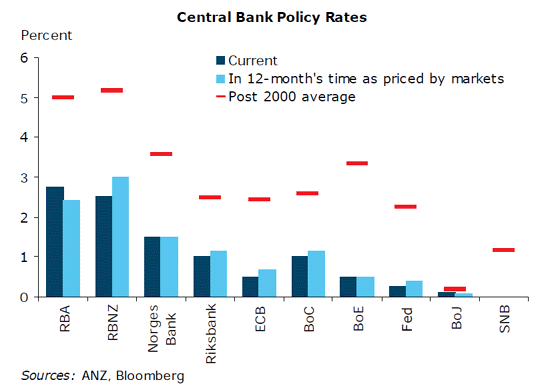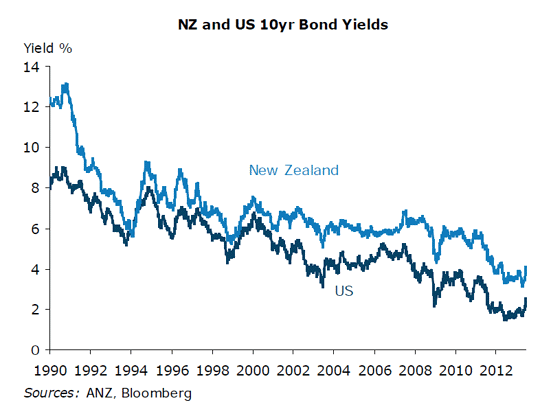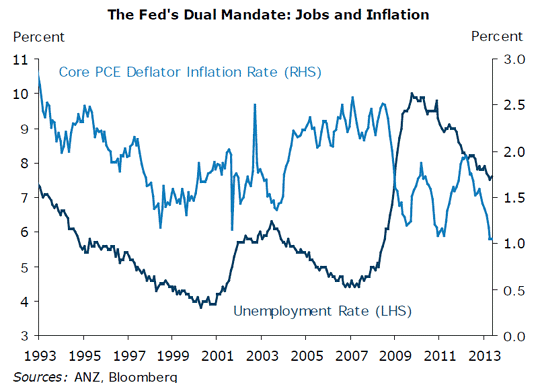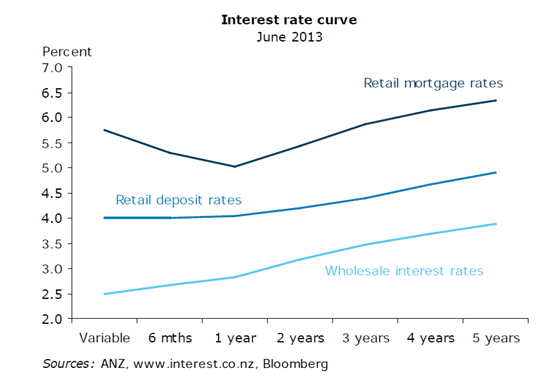This is the feature article in ANZ's monthly Property Focus report for June.
By Cameron Bagrie*
SUMMARY
The environment over the last few years has been one of record low interest rates, both here and abroad. The decision by the US Federal Reserve to set out a conditional timetable for winding down its quantitative easing (QE) programme flags an end to this “golden era”. Wholesale interest rates are sharply higher, and all else equal, there will be pressure for retail rates to follow.
While we’ve seen an end to the era of incredibly low interest rates, it doesn’t naturally follow that rates will trend higher in a sustained fashion. In a post-financial crisis healing world, you don’t see such trends. Movements tend to be of the “drift” variety.
However, the worm has turned: the lows for interest rates have now been seen, though it doesn’t necessarily mean that borrowers should rush in to fix, boots and all.
A TWO-BIT PLAYER AT AN INTERNATIONAL ROULETTE TABLE
The last few years has been characterised by interest rates at multi-year (or decade) lows. Central banks have had their feet firmly on the accelerator for the past four years. Policy rates everywhere have been well below their comparable historical averages: that’s a consequence of cleaning up an economic mess.
In addition to record low policy interest rates, central bank printing presses have been working overtime. In their third bout of quantitative easing since the global financial crisis (termed QE3), the US Federal Reserve are currently purchasing US$85bn of assets per month (buying bonds and other financial instruments), to keep longer-term borrowing costs low.
Central banks in Japan and the UK are also conducting large-scale QE programmes, whereas the European Central Bank has been using various mechanisms to try to grease the wheels and provide liquidity to facilitate greater bank lending. The end result has been historically low interest rates across the board – and not just in those countries carrying out QE. In New Zealand, the Official Cash Rate (OCR) has remained at record lows since early 2011, with mortgage interest rates hovering around 50 year lows.
The correlation between the month-average NZ 5 year bond yields and their US equivalent for the past three years has been 0.82: others’ sugar-pill solution to their economic malaise has kept longer-dated borrowing rates in other countries low too.

In recent months the US Federal Reserve has been preparing the market for the eventual scaling back of the pace of quantitative easing.
The US economy is the bellwether for longer-term interest rates: we all dance to their economic tune. Signs of improvement in the US economy have become more prevalent: it’s not across the board, but more consistent.
While in June the Fed noted that the withdrawal of stimulus would be data dependent, based on their current view of the outlook it expects to start paring back the US$85bn in monthly asset purchases towards the end of the year, with net purchases to have ceased by the middle of 2014.
With the federal funds rate close to zero, the scaling back and eventually ending of QE3 is more akin to easing off the gas pedal than putting on the brakes. However, markets have been quick to respond: US 10-year government bond yields have risen from just 1.63 percent on 2 May to 2.61 percent on 25 June, and are currently just under 2.5 percent.
We’ve seen NZ 10-year government bond yields rise by roughly 1 percentage point (to approximately 4.15 percent) over this period. Domestic wholesale interest rates have risen sharply too, placing upward pressure on retail borrowing rates. Of course retail lending rates are influenced by other factors too, such as international funding costs for banks, which come on top of wholesale interest rates.
It pays to keep an eye on deposit rates as movements in this area often signify pressure for borrowing rates to shift too. However, wholesale interest rates are still a key component, and with this in mind it’s useful to eye what the US Fed is actually articulating and what this means for NZ borrowers.
What steps are the FOMC likely to take in normalising policy settings? Remember in the first instance that US interest rates sit near zero, so the process of normalisation will be a long drawn-out one.
The first step will be the winding down and eventual ceasing of QE purchases. After that the Fed will start lifting interest rates – or tightening monetary policy – in the usual manner, by increasing the fed funds rate. There is likely to be a significant interval between the two periods.
Even after QE has been wound down (say, by mid-2014), the Fed are likely to leave the fed funds rate on hold for a significant period, with the majority of FOMC members in June signalling a 2015 start date to begin lifting it.
Subsequent climbs in interest rates are likely to be gradual, as the Fed has long said that it “expects that a highly accommodative stance of monetary policy will remain appropriate for a considerable time after the asset purchase program ends and the economic recovery strengthens”.
Some time after the first increase in the fed funds rate, the third and final “step” is to normalise the Fed’s balance sheet (i.e. the total stock of bonds bought through QE). We say “step” as this is not necessarily a step that needs to be put into action. Rather, this process is a naturally occurring one – the Fed’s balance sheet will shrink on its own with the passage of time as bonds mature and mortgage bond are prepaid by borrowers.
The Fed could accelerate this process by selling down its bond holdings, but comments from Fed Governors to date suggest that this is unlikely, for fear of roiling markets. However, if the Fed were to sell bonds, this would happen after QE3 is wound down, and after the fed funds rate has been lifted.
At the current point in time, the FOMC is contemplating winding back the amount of stimulus it is providing through QE – step 1. In Fed Chairman Ben Bernanke’s words, at the moment that is seen as likely to begin “later this year”.
What was so important about these words is that for the first time they put a time frame around the “tapering” of QE that markets had earlier been contemplating.
Fed announcements generally have significant knock-on effects in other markets, including New Zealand. As the chart below shows, NZ and US long-term interest rates tend to move up and down together, thanks largely to open financial borders and a common set of investors. Some of the recent lift in US interest rates stems from the fear that the start of “tapering” marks the beginning of the tightening cycle, bringing back memories of 1994 when US 10yr bond yields rose by about 3 percentage points.
However, it has been the unwinding of the QE discount that has added insult to injury. The presence of QE saw yields fall to levels well below those justifiable or consistent with the economic outlook.

Looking ahead, although the Fed will move policy in a measured manner, for markets it’s not about the here and now, but rather the long-term outlook. And now that the Fed has signalled it is pressing the accelerator more gently, the market has jumped to the conclusion that it will soon have its foot on the brake.
We have been here before – but what differs this time around is that US data is in better shape, adding some justification to the Fed’s actions. Indeed, had the market collectively believed the Fed was making a policy mistake and withdrawing policy accommodation too soon (as turned out to be the case after QE1 and QE2), bond yields would likely have fallen. They may well still do that, but for now, the focus is on an improving US economy, and rising interest rates.

What matters for Fed policy is (a) how quickly the unemployment rate falls, with the Fed targeting a 6.5 percent unemployment rate before lifting the fed funds rate; and (b) how inflation evolves.
As the chart above shows, unemployment has been falling steadily, but this is partly the consequence of lower labour force participation as discouraged workers give up, rather than a strongly recovering labour market. If monthly employment growth continues at its recent trend rate, the unemployment rate is likely to approach 6.5 percent by late 2014 to early 2015.
At the moment, inflation (as measured using the core PCE deflator – the Fed’s preferred measure) is well below target, but it is likely to lift as the recovery broadens.
There are two broad channels by which the Fed’s changing stance will affect NZ. The first is via interest rates. Technically, the most recent spike higher in global interest rates can be characterised as a “portfolio shock” caused by the buying/selling decisions of an (admittedly extremely large) market participant – as opposed to reflecting a sudden change in the outlook for the US economy (eg a GDP surprise).
In this light, the spill-over into higher NZ interest rates must be regarded as a negative spill-over. Obviously the Fed’s decision was based on an expectation that US growth will improve. But the point is, the US economic outlook has not improved as much as the recent very sharp rise in US yields would suggest.
The second channel is via the exchange rate. The improving US economic outlook and “tapering” debate have also been associated with a significant fall in the NZD vs the USD. Ironically, this changing mix of monetary conditions is better aligned to the rebalancing requirements of our economy. A lower NZD, all else equal, will feed through into higher inflation and improved growth (export) prospects, with both leading to a higher OCR.
There are thus a number of balls in the air, and we need to keep an eye on how both the exchange rate and global interest rates unfold, for these will be crucial inputs into how the interest rate environment unfolds here in NZ.
There are other channels of which to be mindful. The US economy may be looking better, but what about others? Europe remains a mess. The emerging market economies have been huge beneficiaries of low interest rates in the US (pegged currencies mean they’ve effectively had the same interest rates as Uncle Sam).
Capital has flowed from the core into the periphery, including China (an often-quoted source of upside for the NZ economy). Now we’re seeing flows reverse, out of the periphery back into core markets. That’s raising question marks about the sustainability of activity in the periphery and emerging market economies’ growth trajectory: witness the recent performance across emerging market equities, and growing pricing spikes in short-term money markets that signal cash squeezes.
The message here is not one of impending disaster but one of interlinkages: we reside in a world that is increasingly “coupled”. This means the withdrawal of US policy stimulus will have implications that flow far beyond the US borders.
In short, then, we have entered a new phase. Global interest rates are now heading broadly higher, and we are confident we have now seen the lows in long-term interest rates, which we expect to drift upwards over coming years. However, we can also expect significant volatility as the data evolves, and it is drawing a long bow to suggest the steep increases seen over the past few months will continue.
Indeed, it is entirely possible that the recent lifts in longer-term interest rates following the tapering message will show the US economy’s recovery and thereby push out the tapering profile in and of itself! For New Zealand, this means getting used to longer-term rates gradually rising – as distinct from trending – and a steeper yield curve as the spread between short and long-term interest rates increases.
WHAT DOES IT MEAN FOR NEW ZEALAND BORROWERS?
Typically movements in floating mortgage interest rates tend to reflect domestic considerations, with movements in short-term interest rates largely based on market expectations of what the RBNZ will do to the OCR. Lenders will also charge a premium to reflect the perceived risk of lending to particular sectors or countries: the higher the perceived risk of lending, the higher the interest rate charged.
The gap between the OCR and the 5.74 percent floating mortgage interest rate charged by most banks is currently around 3¼ percent, which is wider than historical norms of around 2 percent. In part this reflects still-elevated bank funding costs for NZ banks, with the global financial crisis seeing a step shift up in funding costs.
This, and the regulatory changes to promote more longer-term or domestic funding for banks has also seen a lift in domestic deposit rates in relation to the OCR as banks attempt to acquire funding from other sources.
Longer-term mortgage interest rates are more sensitive to global factors than shorter-term rates are given the greater sensitivity of longer-term domestic wholesale interest rates to factors affecting global wholesale interest rates. Recent climbs in wholesale interest rates tend to bear this out.
Since early May, domestic 1-year wholesale interest rates have risen by about 20bps (currently 2.84 percent), as opposed to a 40bps rise for 2-year wholesale interest rates (3.23 percent) and a 70bps rise for 5-year wholesale interest rates (3.95 percent). This shift in NZ yields broadly reflects what has happened to US yields. Given recent movements in domestic wholesale interest rates we are likely to see more upward pressure for longer-term fixed mortgage interest rates over time.
While domestic wholesale interest rates have gone up, the impact on actual retail mortgage interest rates has been mild to date, with only small increases to longer-term fixed mortgage rates by some providers. Our estimates of the average mortgage rate applying to bank mortgage debt is around 5.55 percent, a post-2000 low.
Related to this is the fact that the demand for longer-term mortgages is reasonably low, with only around 6 percent of bank mortgage debt fixed for 2 years or more.
While the interest rate worm has turned and the lows for interest rates are now behind us, it doesn’t necessarily follow that borrowers should rush in to fix, boots and all. It’s heroic to believe that the pending unwind of US$85bn of asset purchases – or even the prospect of it – won’t create the odd flutter of economic nervousness.
The global economy still faces huge challenges and any exit of policy stimulus is heavily conditional. Locally, NZ borrowers have been price sensitive and have tended to gravitate towards the cheaper rates on offer. Witness, for example, the $12.4bn rise in bank mortgage debt for 6 to 12 month terms, where
published rates are the cheapest on offer.
Borrowers also like the additional flexibility of being on variable rates, with around half of bank mortgage debt still on floating. All up, around three quarters of the value of bank mortgage debt is either variable or fixed for one year or less, with this proportion rising to about 94 percent if we include rates up to, and including, 2 years.
When interest rates move up the RBNZ will get some economic punch: that’s a reason short-term interest rates shouldn’t have to move up too far. Moreover, the RBNZ is actively looking at bringing in greater prudential oversight mechanisms such as loan-to-value ratio restrictions. They’ll take the heat out of how high the OCR and interest rates need to head as well.

*This article was written by the ANZ economics team which includes chief economist Cameron Bagrie, head of global markets David Croy, senior economist Mark Smith, strategist Carrick Lucas, and economist Steve Edwards.
19 Comments
Yeah its pretty obvious you dont listen, though enough to snarkly say I did say uh something.
I didnt say retail rates, I said OCR. I also said the banks maintained the OCR wasnt a hard link to their rate setting and was more determined by what they could borrow at.
So actually what I said was its more the OCR could go down, but not by much in the medium term, maybe to 2%, even 1.75%. Short term it could rise a bit, as the RBs etc knee jerk and rise until that sends us back into recession. What hapens to the retail rates is determined offshore by the look of it...unfortunately. Will the OCR raise much? I think a max of 4% is possible as an outside chance....but I see no recovery to justify that, not for years.
On top of this of course, the game isnt over til the fat lady sings.
regards
So, are we in a recession or not ? Will higher interest rates increase our cost of living or not ? Will lower exchange rates help us or the importers abroad ? Are our exports price elastic ? We are a housing dependent economy, so if our dollar goes down, does it help the overseas buyers to buy more of our houses and lands, increasing wealth for some, but agony for others who want to start on the housing ladder ?
Beware the Law of Unintended Consequences...There is no certainty for any outcome of these orchestrated movements by Central Banks..They are speculating as good as any one else...
We are in stagnation....No one is getting pay rises, so any rising costs, need a corresponding drop elsewhere.
Exchange rate drops, petrol goes up and another whammy...Imports like TVs/whitewear seem to be dropping, yet exchange rate wont make that easy, I wonder what big retailer will be the first to go under?
I assume overseas buyers are buying to hide their wealth in a safer pot than the one they are in eg china.
CBs I think will screw up, they are pre-positioned to be hawks....they'll finish off what austerity has started in the blink of an eye.
regards
We are in stagnation?
Go read the personalised replies to the BNZ's recent confidence survey.
Over 600 replies, in lots of industries. it's one of the most positive releases on the state of the economy I have seen in a long time.
Tell me we are in stagnation after reading that.
While I was talking on Global terms, yes we have stagnation, NZ is a microcosm of that. This is because I look at the data, inflation is about 1% and steady, un-employment 6% something...globally Eu is recession, little sign Japan is going anywhere, china looks at best not good, USA in poor shape.
Just because some NZ business ppl are feeling more positive presumably do to the housing gains does not translate into a recovery...
Oh and there is a piece on here, kiwis are taking on more debt....so that has to be repaid....with interest.
The RB is talking about doing something....
yeah sure its positive....check back at the end of the year lets see how you did.
regards
What should borrowers do..kick themselves if they have not used the period of manipulated rates to pay down debt..and stay away from more debt.
The worm has indeed turned..and it will grow wings and fly...and the banks will accept no blame for the chaos and pain to come.
Take care your savings are not used to bail out the bankers....that's the plan.
Hint - floating rates can go up, and often for reasons not seen by the few. But AlWAYS, fixed rates go up first to make sure that the complacent floater is truly screwed, especially if the fixed rates have under anticipated the degree of upside, which mostly happens.
Correct Grant A.
I would be a bit careful of these people who say no need to rush over choosing a fixed rate. To me it is more likely there might be surprises in growth on the upside and interest rates could finish up moving up quicker than these economist expect.
There has been one hell of a lot of money pumped into the world's financial system in the last few years. I could pop out somewhere unexpected. Be warned. People were complacent in 1994, in the mid 1960s too.
Very true Landlord - no one knows how that will play out over time, but when you see evidence of a complete lack of understanding by some in the public about what moves interest rates (e.g. "this is how banks make their record profits. Move it up for the majority of the unsuspecting public" - rather than understanding that the global markets moved the yield curve considerably higher in the past month i.e. a big part of their cost of funds) you've got to be a bit fearful for many.
Kimy you are totally fixated on the minor inconsequential detail - banks are only a minor players in determining the level of fixed interest rates. The major issue is their cost of funds which is dictated by the market (and whats driven that up in the past 2-3 weeks in the Fed). Check it out, swap rates are up between 50 - 75 basis points across the curve since early May. Their funding spreads may have come down a touch, who knows, but it will be nothing in comparison to what it now costs them each time they have to go to hedge their mortgage books - they're being squeezed and they will not accept that forever. I assuming you understand nothing of this because you never talk about interest rates from a cost basis, just what bank margins might be. You die focusing on minutia.
I'm with Kimy. Banks are a cartel, and we are paying too much. So obviously their costs are up. But they are maintaining their ridiculous margin, despite excess profits.
As for Grant A. What is this constant apology for the banks in the face of any evidence. Is Grant A a paid PR bank person. If not. What is the reason for his unyeilding (pun intended) campaign.
We welcome your comments below. If you are not already registered, please register to comment.
Remember we welcome robust, respectful and insightful debate. We don't welcome abusive or defamatory comments and will de-register those repeatedly making such comments. Our current comment policy is here.